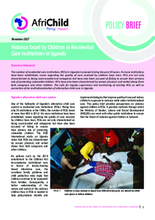Demographic Data
|
Sources: World Bank, UNICEF, UNDP HDR 2015, DHS 2011 |
Displaying 8911 - 8920 of 14391
The Tracking Progress Tool is a free, web-based, interactive diagnostic and learning tool designed to enable national actors to determine the extent to which their country has effectively implemented the Guidelines for the Alternative Care of Children and to identify the priorities for change still ahead.
This study examined predictions of externalizing behaviors (EB) from childhood to adolescence/young adulthood from temperament, preadoption maltreatment, and adoptive family cohesion.
This study examined the status of the State Program on Deinstitutionalization and Alternative Care (SPDAC), a public policy aimed at transforming 55 institutions covering 14,500 children during 2006-2016 in Azerbaijan.
Guided by an ideation-to-action theoretical framework for suicide prevention, the goal of the proposed research study is to describe and identify risk and protective factor correlates of youth suicidal behaviour among those at highest risk for suicide – orphans who reside in a low- and middle-income country (LMIC) institutional setting.
This article from the Phnom Penh Post discusses recent government reforms of orphanages in Cambodia in response to the rising incidence of families sending children to these institutions for educational opportunities that are not available in some communities.
As debates about immigration roil the national political dialogue in the United States, the CPC Learning Network will host a webinar to discuss the mass exodus of
This technical note presents a conceptual framework for localisation in protection and education coordination. It includes a description of the role of coordinators and coordination groups in localization and examples of how localization can be integrated in the humanitarian program cycle.
This report outlines the sessions of a workshop help in London with representatives from four countries participating in a USAID/DCOF-funded activity aimed at intensifying country leadership in advancing national efforts on behalf of children who lack adequate family care, and provides highlights, key discussion points, and action items.
This policy brief explores violence against children in residential care institutions (RCIs) in Uganda and calls for regular supervision and monitoring of existing RCIs as well as promotion of de-institutionalization of alternative child care in Uganda.
This report presents the findings from the Uganda Violence Against Children Survey (VACS), which provides nationally representative data to inform policies and programming aiming to end violence against children in Uganda.





